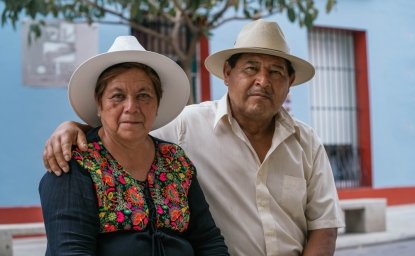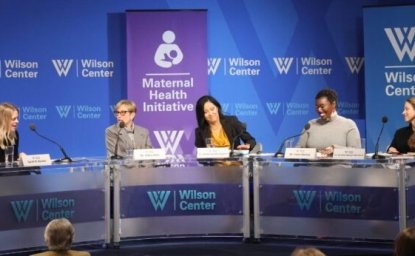Avian Flu: The Next Pandemic?
JANUARY 2006--Lead story from January 2006 issue of Centerpoint
JANUARY 2006--Lead story from January 2006 issue of Centerpoint
The avian "bird" flu may seem like a distant concern, but health officials contend the scenario is not if, but when it will hit the United States, and should the virus become more easily transmissible between people, it would cause a rapidly spreading pandemic and a national crisis. As China enacts a plan to vaccinate billions of chickens for avian flu, "here in the U.S., we are woefully unprepared to vaccinate human beings," observed Senator Tom Harkin at a December 7 Director's Forum.
Earlier, on September 19, the Wilson Center hosted one of Washington's first public meetings on the topic to launch its new Global Health Initiative (GHI). The new initiative examines critical health challenges from AIDS orphans to gene therapy, promotes dialogue among the foreign policy community, and assesses health's impact on development. During the past few months, several of its meetings have focused on avian flu.
H5N1 and the Avian Flu
In 1997, the virus strain H5N1 was detected among the domesticated bird population in Southeast Asia. Since then, these nations have slaughtered more than 100 million chickens, ducks, and other fowl to curb the virus's spread, while China plans to vaccinate all of its poultry. Spreading westward, the virus recently was detected in birds in Romania and Turkey. The overall human toll remains low, but this strain has killed 55 percent of the people infected with it.
The medical community is deeply concerned about an impending outbreak. The September 19 meeting, "Emerging Pandemic: Costs and Consequences of an Avian Influenza Outbreak," sponsored by the Center's Environmental Change and Security Program (ECSP), Asia Program, Global Health Initiative (GHI), and Division of U.S. Studies (DUSS), featured Dr. Michael Osterholm, director of the Center for Infectious Disease Research and Policy at the University of Minnesota, and Helen Branswell, a medical writer for the Canadian Press.
While the seasonal flu kills 35,000 –55,000 Americans each year, scientists predict the avian flu would behave more like the infamous Spanish flu of 1918 that killed as many as 50 million people globally, said Osterholm. Furthermore, lab results from Southeast Asia indicate that H5N1, like the Spanish flu, would be most deadly for the healthiest segments of the population, ages 18-40, unlike seasonal flu which disproportionately kills children and the elderly. If H5N1 proves as lethal to humans as the Spanish flu, Osterholm estimates it could kill 180 million–360 million people worldwide. With an outbreak, said Branswell, "every jurisdiction is going to need every single doctor, nurse, lab technician, orderly, and paramedic they can muster."
Critical Dialogues
On November 30, the Wilson Center and Cornell University convened representatives from the public health, animal health, and wildlife management communities to address human and animal health concerns.
Alfonso Torres, executive director of the Animal Health Diagnostic Center and associate dean at Cornell University's College of Veterinary Medicine, expressed concern about Southeast Asia's growing population and the close proximity of people to animals. Developing countries, he said, will generate 60 percent of the world's meat and 52 percent of its milk by 2020. He said, "This will lead to an increase in the possibility of diseases coming to us from the developing world."
Director of the Wildlife Conservation Society's Field Veterinary Program William Karesh described the close proximity of people and animals in Asia. Showing a photo of a woman sleeping with her arms around a peacock, he said, "In most poor countries, animals are mixed with people and you have a constant mix of bacteria and viruses."
The pet trade further exacerbates the mix of animals and bacteria. Karesh said that a Thai market his team studied sold more than 70,000 birds from hundreds of species in six months. The trade routes are diverse and include wild animals shipped to destinations around the world. "It's going to require a lot of education and sincere effort to prevent [diseases from spreading]."
"Each year, the average person consumes 253 eggs, 16 pounds of turkey, and 87 pounds of chicken," said Spangler "Buzz" Klopp, a corporate veterinarian for the poultry company, Townsends, Inc. The U.S. Department of Agriculture closely monitors poultry through vertical integration, whereby every process—from incubation and hatching to delivery to the grocery store—is contained to avoid contamination from unclean sources. "This is our fundamental means of biosecurity," Klopp said.
Lonnie King, dean of Michigan State University's College of Veterinary Medicine, said, "We have to build infrastructures in health systems in developing countries, not just human health, but animal health too."
Preventing, Conquering the Avian Flu
The health and policy communities concur that a strong international health alliance is needed to prevent an avian flu pandemic. Karesh advocated educating people in developing nations about the behaviors and customs that make them susceptible to disease.
"We have to plan as if this will happen tonight," said Osterholm. But only nine countries produce the world's supply of flu vaccine, and the United States produces all of its flu vaccine at just one plant in Pennsylvania.
"We have enough doses of antiviral medication for less than two percent of our population," warned Senator Harkin. The World Health Organization recommends having enough for 25 percent, as France and Britain do.
Another concern is the lack of public information. Branswell recommends that governments around the world share their disaster plans with the public so people can prepare themselves and their families for an outbreak.
Senator Harkin expressed concern over the lack of state and local preparedness. Agencies and hospitals are under-funded, understaffed, and ill-equipped to cope with a pandemic. He recently helped secure government funding for improving state and local public health infrastructure, stockpiling vaccines, and facilitating early detection by bolstering surveillance of outbreaks overseas.
History of Epidemics in the United States
Airplanes enable diseases to spread across continents in just hours but pandemics have spread around the world for centuries. At a seminar sponsored by DUSS, ECSP, and GHI in December, scholars examined pandemics in recent history, public policy responses, and lessons learned.
The key lesson was that epidemics can be conquered only with the truth. From 1906-1940, some 100,000 Americans died of pellagra, a nutritional deficiency common among the southern poor, said Alan Kraut, a history professor at American University. But southern politicians denied rampant poverty and argued pellagra was an infectious disease, thus delaying federal relief. Kraut said, "Public intransigence plays as big a role
as any germ or missing nutrient."
The federal government responded to the 1918 Spanish flu by suppressing information and denying any health threat, said John Barry of the Center for Bioenvironmental Research at Tulane and Xavier universities. As people saw their loved ones dying from this flu en masse, however, public panic ensued and public life all but ceased in many cities.
Government response also was lax during the venereal disease (VD) epidemic affecting the military during World War I and in early responses to the AIDS pandemic. Congress did provide funding and create a division in the U.S. Public Health Service (PHS) to combat VD, said John Parascandola, a PHS historian. But a backlash of socio-political forces forced the PHS to emphasize morality in its educational materials—and to imprison women suspected of prostitution around military camps—rather than to equip the public with knowledge.
In the early 1980s, the U.S. government chose to ignore AIDS, as the highest initial incidences occurred among stigmatized groups such as homosexuals and drug users, said Victoria Harden of the National Institutes of Health. In fact, the U.S. Surgeon General did not authorize an educational campaign until 1988, and the stigma continues to impede public health responses.
Lessons from past epidemics reveal the importance of public education, coordination among all levels of government, and enabling medical need to take precedence over moral considerations. It remains to be seen how the policy community will handle the next wave of pandemics.

Housed within the Wilson Center's Environmental Change and Security Program, the Maternal Health Initiative (MHI) leads the Wilson Center’s work on maternal health, global health equity, and gender equality. Read more


The Environmental Change and Security Program (ECSP) explores the connections between environmental change, health, and population dynamics and their links to conflict, human insecurity, and foreign policy. Read more




